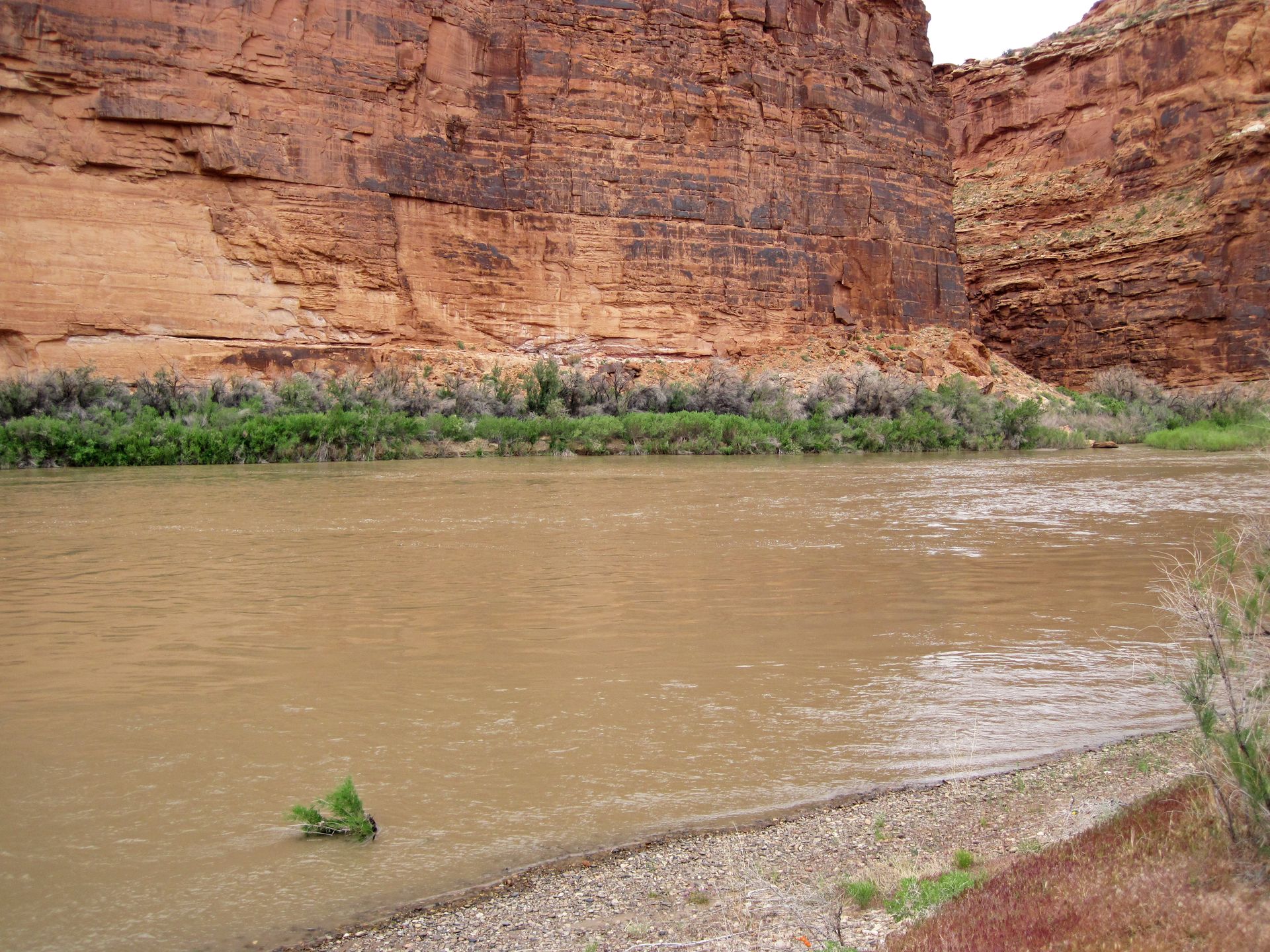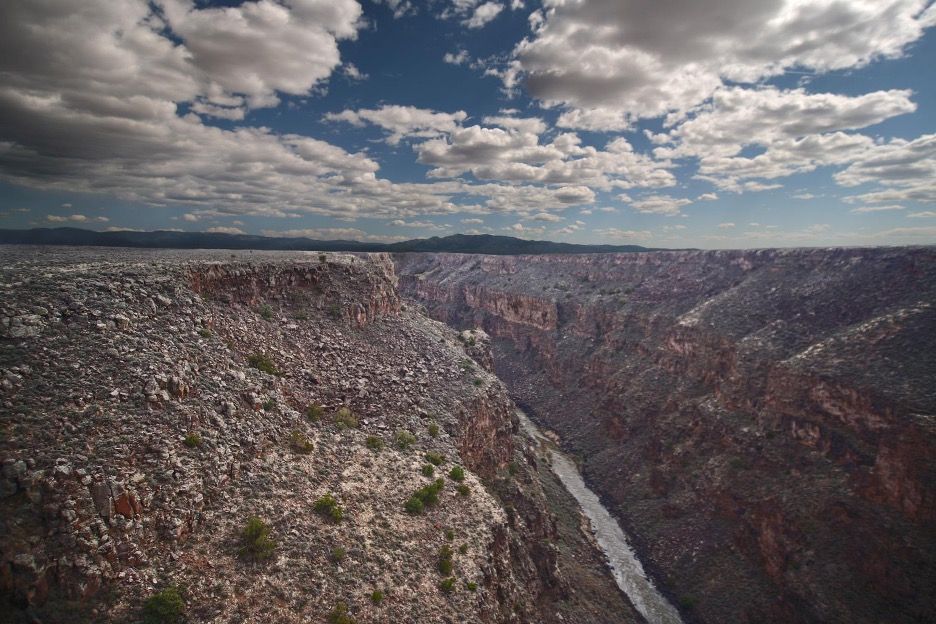Colorado Efforts to Protect Water Resources
Water shortages in Colorado have prompted negotiations between the Colorado River Basin states regarding how best to cut water use. Recent estimates suggest that California, Arizona, Nevada, New Mexico, Colorado, Utah, and Wyoming must cut their current allocation by thirty percent.[i] Although snowpack in Colorado is currently one hundred and forty percent of average, more is needed to curb the water crisis in the West.[ii] To aid in negotiations, four senators from Colorado, Wyoming, and Nevada are touring the nation’s depleted reservoirs and infrastructure.[iii] Water conservation in the West is crucial to address the water crisis. A recent poll suggests that seventy to ninety percent of Coloradans support conservation goals such as “healthy forests, protecting wildlife habitats and migration routes and preventing light pollution.”[iv] Eighty-seven percent of respondents in Colorado see water shortages as a problem, and seventy-seven percent of respondents believe in urgent funding for water conservation projects in Colorado.[v] To address these concerns, Governor Polis signed several bills in 2022: The Construction Fund Projects Bill; the Wildfire Prevention Watershed Restoration Funding Bill; the Turf Replacement Program Bill; the Groundwater Compact Compliance Bill; and the Species Conservation Trust Fund.[vi]
Construction Fund Projects Bill
The Construction Fund Projects Bill allocates resources to fund several projects aimed at water conservation within Colorado.[vii] Several of these projects address water monitoring systems in Colorado.[viii] Specifically, the Bill allocates funding towards satellite monitoring systems, floodplain map modernization, water forecasting partnership project, and modeling and data analyses for the upper Colorado river commission's interstate planning and negotiation effort.[ix] Monitoring and forecasting water in Colorado is crucial to water conservation efforts so that policymakers can accurately predict the cuts necessary to sustain the population and environment.
This Bill also allocates thirteen million dollars to Breckenridge, Colorado to rehabilitate the Goose Pasture Tarn Dam.[x] This project is expected to cost twenty million dollars, funded by both Breckenridge and the Federal Emergency Management Agency.[xi] The rehabilitation project will replace current spillways with a single spillway to improve safety around the dam.[xii] The U.S. Army Corps of Engineers classified the dam as a high hazard based on the consequences should the dam fail, presumably relating to the potential flood risks posed to local residents.[xiii] Safer water infrastructure will prevent future water waste. Ensuring that the Goose Pasture Tarn Dam will not fail furthers conservation efforts by reducing the possibility of waste.
Wildfire Prevention Watershed Restoration Funding Bill
The Wildfire Prevention Watershed Restoration Funding Bill allocates funds to several projects aimed at the restoration of watersheds and mitigation of wildfire risks.[xiv] Specifically, the Bill allocates three million dollars to reduce wildfire risks by promoting wildfire resilience.[xv] The Bill also allocates ten million dollars for watershed restoration and flood mitigation grants.[xvi] These efforts will benefit Coloradans by mitigating the risk that wildfires pose to water resources, homes, health, and the environment.
In recent years, the West has experienced serious issues regarding smoke and wildfires. For example, many Coloradans remember the destruction of the Marshall Fire in December 2021, which destroyed as many as one thousand homes and businesses in Boulder County.[xvii] Climate change will inevitability expose the West to more frequent and devastating wildfires. Wildfires also implicate water conservation efforts in Colorado. Researchers at CSU have found that burned areas in the mountains hold less water in snowpack than most areas.[xviii] Wildfires themselves compromise water quality for years after being extinguished.[xix] In addition, flooding and erosion are common on burned watersheds, which can have negative impacts on the water supply.[xx]
Turf Replacement Program Bill
The Turf Replacement Program Bill requires the Colorado Water Conservation Board (“CWCB”) to develop an incentive program for the “voluntary replacement of irrigated turf with water-wise landscaping.[xxi] This would mean incentivizing the use of plants and grasses with low water needs.[xxii] Coloradans are already experiencing water restrictions targeted towards landscaping in the summer months. Many cities in Colorado have taken steps of their own to reduce residential water use. In Denver, homeowners are only allowed to water their lawns in the morning and evenings and no more than three times a week.[xxiii] The Turf Replacement Program Bill builds upon another bill passed in 2021, which prohibited homeowner association restrictions on “xeriscape, nonvegetative turf grass, and renewable energy-generation devices.”[xxiv] Homes within common interest communities often use dramatically more water than those not within common interest communities – nearly ten thousand gallons more on average.[xxv]
Xeriscaping is an alternative for businesses and homeowners to reduce water consumption. Xeriscaping means “dry-scaping” in Greek.[xxvi] As an alternative to grass lawns, Xeriscaping encourages the use of plants that need little water. Watering a grass lawn can make up as much as 30% of a household’s water consumption.[xxvii] Xeriscaping can significantly cut a household’s water use. As city water restrictions become stricter, more Coloradans will likely implement xeriscaped lawns. The CWCB should provide large rebates and tax benefits to those who use water-wise landscaping. Administering an incentive program will likely be much easier than enforcing city-level water restrictions.
In Pueblo, the Water Department is offering residents five hundred dollars to implement a xeriscaped lawn.[xxviii] Aurora Water also recently launched a rebate program, offering four thousand dollars to homeowners who replace five hundred feet of grass in their front lawn.[xxix] The Turf Replacement Program will continue to build on city programs.[xxx] The Aurora plan should serve as an example to other municipalities. Showing residents that xeriscaping can be affordable and beautiful will go a long way to reduce household water consumption.
Why don’t more people remove their lawns and implement xeriscaping given the water savings associated with this type of landscaping? The practice of planting of lawns in America dates back to the colonial period, and lawns have often been associated with wealth.[xxxi] Grass lawns were historically difficult to maintain and required homeowners to devote time, spend money, and hire workers to assist with their lawns.[xxxii] This theme continues today – a green lawn is associated with success.[xxxiii] This sociological phenomenon will present a challenge to persuading more people in the West to switch to xeriscape landscaping. Strong financial incentives and rebate programs are necessary to get homeowners and businesses interested in eliminating the traditional grass lawn.
Groundwater Compact Compliance Bill
The Groundwater Compact Compliance Bill aims to “finance groundwater use reduction and sustainability efforts.”[xxxiv] Specifically, this bill will allow the state to buy and retire irrigation wells throughout Colorado.[xxxv] The Rio Grande Water Conservation District agreed to pay three thousand dollars per acre-foot to retire groundwater wells.[xxxvi] Agriculture is the largest use of Colorado groundwater.[xxxvii] Sixty million dollars have been set aside from the state’s budget to buy wells in the Rio Grande River Basin and the Republican River Basin.[xxxviii] The aquifers in these basins are particularly struggling. Water use in these areas is limiting Colorado’s ability to comply with the Colorado River Compact.[xxxix] Additionally the aquifers are drought-stressed and need to recover.[xl]
Species Conservation Trust Fund
The Species Conservation Trust Fund was initially created in 1998.[xli] The Trust funds studies and programs to help threatened, endangered, and candidate species recover.[xlii] In 2022, six million dollars were allocated towards Native Terrestrial Wildlife Conservation, Native Aquatic Wildlife Conservation, Platte River Recovery Implementation Program, Upper Colorado River Endangered Species Recovery Program & San Juan River Basin Recovery Implementation Program, Ruedi Reservoir releases, and Selenium management.[xliii]
Protecting biodiversity and water conservation go hand-in-hand. In Colorado, while wetlands comprise only three percent of the state, they support over forty percent of all vascular plant species, including 100 species of rare and vulnerable plants.[xliv] Additionally, eighty percent of all Colorado wildlife is supported by the wetlands at some point in its lifespan.[xlv] Colorado wetlands host the most at-risk species in comparison to all other habitats.[xlvi] Water conservation and protection of wetlands are critical to preserving biodiversity in Colorado. The state of Colorado has created its own list of threatened and endangered species, which include several fish, amphibian, bird, mammal, reptile, and mollusk species.[xlvii]
These bills are a step in the right direction to further water conservation in Colorado. Given the threat of climate change, more steps will inevitably become necessary to mitigate drought, wildfire, and species loss. Colorado should continue to fund water projects, especially considering most Coloradans support these efforts. Colorado’s efforts can serve as an example among other Colorado River Basin states needing to curb water consumption. Financial incentives like those in the Groundwater Compact Compliance Bill and the Turf Replacement Program Bill encourage Coloradans to take positive steps toward water conservation. Additionally, maintaining safe and efficient infrastructure and monitoring systems, restoring watersheds, and protecting wetland biodiversity further the state’s interest in protecting water supplies and habitats.
SOURCES
[i] Ella Nilsen,
A Showdown Over Colorado River Water is Setting the Stage for a High-Stakes Legal Battle, C.N.N. News (Jan. 30, 2023),
https://www.cnn.com/2023/01/30/us/colorado-river-water-california-arizona-climate/index.html.
[ii] Jerd Smith, It’s all White: Colorado’s Statewide Snowpack Tops 140%, Though Reservoirs are Still Low, The Colorado Sun (Mar. 30, 2023), https://coloradosun.com/2023/03/30/colorado-snowpack-reservoirs-drought/.
[iii] Ella Nilsen, Senators to Tour Colorado River as Water Negotiations Reach Critical Juncture, C.N.N. News (March 30, 2023), https://www.cnn.com/2023/03/30/politics/colorado-river-senators-trip-climate/index.html.
[iv] Dan Boyce, Coloradans Want More Investment in Water Conservation, New Poll Finds, C.P.R. News (Feb. 15, 2023), https://www.cpr.org/2023/02/15/coloradans-want-more-investment-in-water-conservation-new-poll-finds/.
[v] Boyce, supra note iv.
[vi] Governor Polis Signs Multiple Bills Funding Critical Water Conservation Programs, Colo. Water Conservation Bd. (June 9, 2022), https://cwcb.colorado.gov/news-article/polis-signs-water-bills.
[vii] Colorado Water Conservation Board Construction Fund, Colo. Gen. Assemb., https://leg.colorado.gov/bills/HB22-1316 (last visited Apr. 2, 2023).
[viii] Colorado Water Conservation Board Construction Fund, supra note vii.
[ix] Colorado Water Conservation Board Construction Fund, supra note vii.
[x] Colorado Water Conservation Board Construction Fund, supra note vii.
[xi] Taylor Sienkiewicz, Construction to Start on Goose Pasture Tarn Dam Repair this Month, Summit Daily (Apr. 4, 2021) https://www.summitdaily.com/news/local/construction-to-start-on-goose-pasture-tarn-dam-repair-this-month/.
[xii] Sienkiewicz, supra note xi.
[xiii] Sienkiewicz, supra note xi.
[xiv] Wildfire Prevention Watershed Restoration Funding, Colo. Gen. Assemb., https://leg.colorado.gov/bills/hb22-1379 (last visited Apr. 2, 2023).
[xv] Wildfire Prevention Watershed Restoration Funding, supra note xiv.
[xvi] Wildfire Prevention Watershed Restoration Funding, supra note xiv.
[xvii] Jessica Seaman et al., Marshall Fire May Have Destroyed 1000 Homes in Boulder County, Officials Say, The Denver Post (Dec. 31, 2021), https://www.denverpost.com/2021/12/31/marshall-fire-boulder-county-friday/.
[xviii] Chris Outcalt, Will Massive Western Wildfires Leave More or Less Water in Rivers?, The Colorado Sun (May 6, 2022), https://coloradosun.com/2022/05/06/wildfires-impact-snowpack-water-colorado/.
[xix] Wildfires and Water Quality, The U.S. Geological Surv., https://www.usgs.gov/centers/california-water-science-center/science/science-topics/wildfires-and-water-quality#:~:text=Wildfires%20can%20compromise%20water%20quality,and%20drinking%2Dwater%20treatment%20processes (last visited Apr. 2, 2023).
[xx] Wildfires and Water Quality, supra note xix.
[xxi] Turf Replacement Program, Colo. Gen. Assemb., https://leg.colorado.gov/bills/hb22-1151 (last visited Apr. 2, 2023).
[xxii] Turf Replacement Program, supra note xxi.
[xxiii] Rules for Outdoor Water Use, Denver Water, https://www.denverwater.org/residential/rebates-and-conservation-tips/summer-watering-rules (last visited Apr. 2, 2023).
[xxiv] Alicita Rodriguez, HOAs Go Green: Colorado Bill Forces HOAs to Accept Fake Grass and Solar Panels, C.U. Denver News (July 19, 2021), https://news.ucdenver.edu/hoas-go-green-colorado-bill-forces-hoas-to-accept-fake-grass-and-solar-panels/.
[xxv] Rodriguez, supra note xxiv.
[xxvi] Justin Stabley, What is Xeriscaping? How You Can Turn Your Lawn into a Sustainable Oasis, P.B.S. News (Sept. 5, 2022), https://www.pbs.org/newshour/science/how-xeriscaping-offers-a-water-efficient-environmentally-friendly-alternative-to-lawns.
[xxvii] Stabley, supra note xxvi.
[xxviii] Jaleesia Fobbs, Pueblo West Water Dept. Offering Residents $500 Toward Lawn Replacement and Xeriscaping, KRDO NEWS (Mar. 14, 2023), https://krdo.com/top-stories/2023/03/14/pueblo-west-water-dept-offering-residents-500-toward-lawn-replacement-and-xeriscaping/.
[xxix] Danielle Kreutter, Aurora Water Launches Rebate Program to Cover Some of the Cost of Replacing Lawns with Xeriscaping, Denver 7 News (Mar. 8, 2023) https://www.denver7.com/news/front-range/aurora/aurora-water-launches-rebate-program-to-cover-some-of-the-cost-of-replacing-lawns-with-xeriscaping.
[xxx] Hannah Metzger, Colorado to Incentivize Residents to Replace Grass Lawns with Water-saving Landscaping, Colo. Politics (June 8, 2022), https://www.coloradopolitics.com/legislature/colorado-to-incentivize-residents-to-replace-grass-lawns-with-water-saving-landscaping/article_7788d4b4-e764-11ec-a734-6732680dbbe4.html.
[xxxi] Krystal D’Costa, The American Obsession with Lawns, Scientific American (May 3, 2017), https://blogs.scientificamerican.com/anthropology-in-practice/the-american-obsession-with-lawns/.
[xxxii] D’Costa, supra note xxxi.
[xxxiii] D’Costa, supra note xxxi.
[xxxiv] Groundwater Compact Compliance Fund, Colo. Gen. Assemb., https://leg.colorado.gov/bills/sb22-028 (last visited Apr. 2, 2023).
[xxxv] Groundwater Compact Compliance Fund, supra note xxxiv.
[xxxvi] $3,000 per acre-foot to Retire Groundwater Wells, Alamosa Citizen (Mar. 3, 2023), https://www.alamosacitizen.com/3000-per-acre-foot-to-retire-groundwater-wells/.
[xxxvii] Groundwater, Colo. Geological Surv., https://coloradogeologicalsurvey.org/water/groundwater/#:~:text=Agriculture%20is%20the%20largest%20user,domestic%20water%20needs%20as%20well (last visited Apr. 2, 2023).
[xxxviii] Michael Elizabeth Sakas, To Help Refill Two Struggling Underground Aquifers, Colorado Lawmakers Set Aside $60 Million to Retire Irrigation Wells and Acres of Farmland, C.P.R. News (May 13, 2022), https://www.cpr.org/2022/05/13/colorado-aquifers-rio-grande-republican-river-basins-groundwater/.
[xxxix] Larry Morandi, Bill Providing Millions in Relief to Republican, Rio Grande River Basins Clears First Hurdle, Water Educ. Colo. (Feb. 16, 2022), https://www.watereducationcolorado.org/fresh-water-news/bill-providing-millions-in-relief-to-republican-rio-grande-river-basins-clears-first-hurdle/.
[xl] Morandi, supra note xxxix.
[xli] Species Conservation Trust Fund, Colo. Water Conservation Bd. https://cwcb.colorado.gov/species-conservation-trust-fund (last visited Apr. 2, 2023).
[xlii] Species Conservation Trust Fund, supra note xli.
[xliii] Species Conservation Trust Fund, supra note xli.
[xliv] Wetlands are Critical for Supporting Rare and Vulnerable Plant Species, Colo. Wetland Info. Ctr., https://cnhp.colostate.edu/cwic/condition/biodiversity-significance/#:~:text=Wetlands%20are%20critical%20for%20supporting,rare%20and%20vulnerable%20plant%20species (last visited Apr. 2, 2023).
[xlv] Wetlands are Critical for Supporting Rare and Vulnerable Plant Species, supra note xliv.
[xlvi] Wetlands are Critical for Supporting Rare and Vulnerable Plant Species, supra note xliv.
[xlvii]
Threatened and Endangered List, Colo. Parks & Wildlife,
https://cpw.state.co.us/learn/pages/soc-threatenedendangeredlist.aspx (last visited Apr. 2, 2023).



